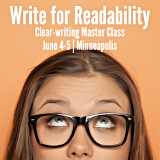Sentence length, word length make messages more readable
Want to see your Flesch Kincaid Grade Level drop? Your Flesch Reading Ease soar? Your Automated Readability Index hit the right target? Other readability test scores move in the right direction?

If so, focus your time and energy on the top 2 drivers of readability.
What’s this?
Since the 1880s, researchers have proven — again and again — that sentence length and word length are the 2 strongest indicators of readable copy.
Whether you’re writing a news release or content-marketing piece, you can improve your readability — and your writing style — by doing these 2 things:
1. Shorten your sentences.
In the 130 years since researchers started quantifying readability, dozens of researchers have proven that sentence length is the No. 2 predictor of reading ease.
Specifically, researchers found that:
- Long sentences reduce readability. In 1928, Mabel Vogel and Carleton Washburne of Winnetka, Illinois, published 19 writing attributes that make messages harder to read. Nearly half centered on sentence length and complexity, including words per sentence, simple sentences and conjunctions.
- Short sentences are easier to understand. Long sentences decrease comprehension, found readability researcher Ralph Ojemann in 1934. He found that sentences including prepositions and dependent clauses reduced understanding.
- The higher the number of clauses, the lower the comprehension. The more indeterminate clauses a passage includes, the harder it is to understand, found Ralph Tyler and Edgar Dale in 1934. Why? Indeterminate clauses make sentences longer and increase the number of ideas per sentence.
- Sentence length, prepositions drive readability. Edmund B. Coleman found in 1965 that he could achieve a virtually perfect reading grade level correlation by measuring just four elements, including sentence length and the percentage of prepositions.
- Long sentences reduce comprehension. Five sentence characteristics — including length, passive voice and embedded clauses — affected comprehension, found readability expert G. R. Klare in 1976.
- Short, simple sentences boost reading ease. Shortening and simplifying sentences made copy six grade levels easier to read, found researchers Thomas Duffy and Paula Kabance in 1981.
2. Shorten your words.
While sentence length is the No. 2 predictor of readability, word length is No. 1. So the fastest way to improve readability is to shorten polysyllabic long words.
Here’s what the researchers found:
- Long words are harder to read. Remember Vogel and Washburne from Winnetka? Of their 19 writing attributes that make messages harder to read, the top three centered on word familiarity.
- Familiar words are easier to understand. Comprehension increases with word familiarity and ease, found Ojemann in 1934. Word difficulty was among the top four factors he found that reduce understanding.
- Jargon, unfamiliar words reduce comprehension. The top two predictors of comprehension, found Tyler and Dale in 1934, are the amount of jargon and the number of long or unfamiliar words.
- Vocabulary top predictor of difficulty. “Vocabulary load is the most important [accompaniment to] difficulty,” found Irving Lorge, a psychologist at Columbia University Teacher’s College, in 1944.
- Common words boost understanding. Using only percentage of common words and average number of words per sentence, Dale and Chall in 1948 published a readability formula that predicted comprehension with a 92% accuracy rate.
- One-syllable words increase comprehension. Shorter words increase understanding, found Coleman in his 1965 study measuring the percentage of one-syllable words.
- Word familiarity increases understanding. Word characteristics including functionality, familiarity and length affect comprehension, found Klare in a 1976 review of 36 readability studies.
- Short, simple words boost readability. Shortening and simplifying words reduced the reading grade level from 11th to 5th in a 1981 study by Duffy and Kabance.
It takes 2.
Want to dramatically improve readability, understanding and comprehension? Write short, simple sentences comprising short, familiar words.
Make every message more readable.
Want more tools for improving readability scores?
Until Jan. 31 only, get nearly $300 worth of learning tools free with a Silver or Gold ticket.
|
